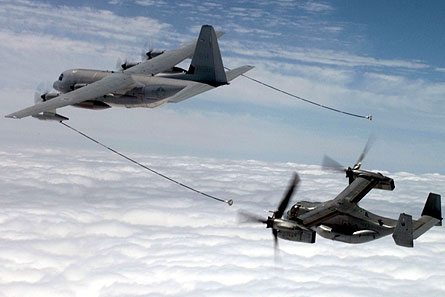US Marine Corps crews successfully completed two non-stop flights of the Bell Boeing V-22 Osprey between the east and west coasts of the USA in preparation for the tiltrotor's forthcoming flight to the UK, where it will be appearing at the Farnborough air show next month.
The Marines are conducting the long-distance flights to develop tactics, techniques and procedures for long-range, over-water movements of Marine variant MV-22s, the Corps says, in preparation for the first combat deployment in 2007.
Two Ospreys, operated by Marine Tiltrotor Operational Test and Evaluation Squadron 22 (VMX-22), took off from the their home base of Marine Corps Air Station New River in North Carolina on Monday 12 June and flew to Marine Corps Air Station Miramar in California. The journey took 9h to cover a distance of 2,100nm (3,885km). The return trip, performed on Thursday, took 8h, flying at altitudes of 14-000-16,000ft (4240-4850m) and flying at 240-300kt (445-555km/h).
The coast-to-coast flights were test runs for the first transatlantic deployment next month to the UK. An Osprey will depart from Goose Bay, Newfoundland, Canada on 10 July, flying direct to the UK with two tankers. In the UK, the aircraft will be turned over under a lease agreement to manufacturer Bell Boeing, which will operate the aircraft in the Royal International Air Tattoo and Farnborough air show.

During the US flights, the VMX-22 crews completed two aerial refuellings en route (pictured above) with Lockheed Martin KC-130J tankers from Squadron 252. The Marines say only one refuelling was necessary to complete the mission, but that the squadron wanted to test the MV-22's long-range fuel system capabilities.
"This will be the first time that an assault support aircraft has ever flown across the Atlantic," says Col Bill Taylor, V-22 Osprey joint programme manager. "This is invaluable as far as establishing the tactics, techniques and procedures for these types of missions in co-ordination with the KC-130s," he adds. "Unlike conventional rotary wing aircraft, which must be transported overseas, the V-22 can self-deploy thousands of miles over water to get itself to the fight," says Taylor.
"This [transatlantic mission] is invaluable as far as establishing the tactics, techniques and procedures for these types of missions in coordination with the KC-130s," says Lt Col Chris Seymour, VMX-22 executive officer and pilot of one of the two Ospreys. "We're writing the book on how to do this."
The Marine Corps is using the opportunity to fly to the UK as a first step to gain experience and refine skills, Taylor said, before the Marines take the aircraft across the ocean into a theatre of battle.
Source: Flight International
















